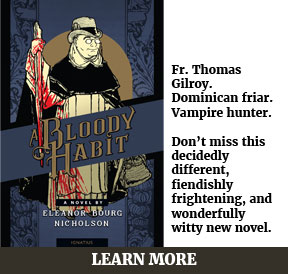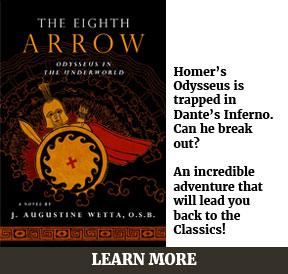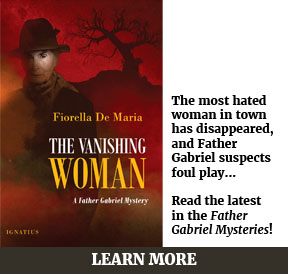
While the mystery genre rarely (some contend never) rises to the heights of great literature, there are mystery authors who are masters (yes, masters!) at elements of the craft of writing.
Arthur Conan Doyle is skillful at conveying emotional atmosphere – think about The Hound of the Baskervilles and The Speckled Band – and in his depiction of the original and never equaled Sherlock Holmes, utterly cerebral, in contrast to his desperate, distracted clients.
G. K. Chesterton is masterful at contrasting the public man with the interior man via the unassuming but perspicacious Fr. Brown, and at turning conventional wisdom upside down. In most of Chesterton’s short mysteries, Fr. Brown progresses from a deferential observer/interlocutor to a gale force wind of wisdom at the story’s denouement. Today, we see Chesterton as a finished product, but much that we now respect in Chesterton came from his lifelong passion for articulating truth and meaning in fresh and challenging ways.
Earl derr Biggers (Charlie Chan), also an accomplished journalist and playwright, gives us vivid snapshots of turn-of-the-century Honolulu and San Francisco; the novels, not the inane films. His Charlie Chan is subtle and provocative. Start with The House Without A Key, Chan’s first case, and immerse yourself in a rapidly changing Honolulu. Another story, Charlie Chan Carries On, takes the reader around the world.
As for the queen of crime, Agatha Christie, consider Hercule Poirot’s flamboyant persona combined with his Christian beliefs and virtues, or Miss Marple’s Victorian persona combined with a mind capable of plumbing the depths of depravity, both invariably underestimated, even by those who should know better. Her little known, but delightful, Harley Quin short stories are nothing less than mystical mysteries. Easy to think of Christie as a writer’s writer, churning out stories, living a placid productive life…hardly: two far-from-perfect marriages, along with the burden of public and commercial expectations.
Read S.S. Van Dine (Philo Vance) to sample the positivism of the late 19th and early 20th centuries when many believed that all human behavior could be reduced to psychological and genetic predispositions. Van Dine’s stories, set in jazz-age Manhattan (or a “Gotham” based on Manhattan), are chock-full of cultural and philosophical asides. Van Dine was the penname of Willard Huntington Wright, a literary editor and critic, who might never have composed these stories if he hadn’t experienced an emotional breakdown, read mystery stories as therapy, and decided to try his hand at the genre.
John Dickson Carr, an anti-positivist and contemporary of Christie, Van Dine, and Dorothy L. Sayers, the Thomas Edison of mystery writers, excels at astounding and befuddling readers and, like Doyle, atmosphere is another of his strengths. No one has crafted such intricate puzzles as Carr (The Three Coffins, The Judas Window), though his character portrayals will never be confused with great literature. Carr is the first mystery writer to base a fictional detective (Dr. Fell) on a historical mystery writer (G. K. Chesterton), though most Chestertonians insist that the resemblance is only superficial.
Rex Stout’s Nero Wolfe mysteries are rather ordinary but his humor is superb, on par with Evelyn Waugh’s farces. The best of Stout’s humor (try Too Many Cooks, with much of the story occurring at a resort modeled on the Greenbriar) is laugh-out-loud funny, and deliciously written. In “Too Many Cooks”, the 300-pound plus Wolfe would do anything to get his hands on a recipe: “It was not called saucisse minuit then; it was merely sausage of the house in a little inn in a little Spanish town…I recognized that sausage as high art. I remember well: the first one I ate, I suspected and feared that it was only an accidental blending of ingredients carelessly mixed; but the others were the same, and all those in the subsequent three dishes. It was genius. My palate hailed it in that place. I am not one of those who drive from Nice or Monte Carlo to the Corridona at San Remo for lunch because Jerome Berin is famous and saucisse minuit is his masterpiece. I did not have to wait for fame to perceive greatness; if I took that drive it would not be to smirk, but to eat.” Too bad that like many who produce sequel after sequel, Stout’s once fresh characters eventually become caricatures of themselves, sapped of originality.
What to say about Ellery Queen, whose early story detective is Sherlockian, but morphs into a psychologically insightful everyman in the later stories? Stick to the early stories, as these are the best (especially The Greek Coffin Mystery and The Egyptian Cross Mystery). Queen – two cousins by the name of Dannay and Lee – aren’t masters of character portrayal, dialogue, or humor, but they produced a handful of darn good mystery stories in the 1930s. In my view, The Greek Coffin Mystery is one of the best puzzle plot mysteries ever written. As time passed, Dannay and Lee became entrepreneurs who, by adaptation, evolution, and accommodation, made a lucrative franchise out of Ellery Queen.
Raymond Chandler, disdaining puzzle plots like those crafted by Carr, Christie, and Queen, immerses the reader in the dark side of human nature. You will be hard pressed to find of hint of virtue in Chandler’s Los Angeles outside of Marlowe’s instinctive integrity, along with one of the most obtuse spirits in literature. And Chandler was a drunk (in Chandlerian lingo) who wrote candidly and elegantly about what makes drunks tick. Some of Chandler’s writing is pure magic: “A white night for me is as rare as a fat postman. If it hadn’t been for Mr. Howard Spencer at the Ritz-Beverly I would have killed a bottle and knocked myself out. And the next time I saw a polite character drunk in a Rolls-Royce Silver Wraith, I would depart rapidly in several directions. There is no trap so deadly as the trap you set for yourself” (The Long Goodbye).
Accounting for the different eras in which they composed their stories, there are similarities between Dorothy L. Sayers and P. D. James. Both are strong writers for whom the mystery story is a vehicle to explore a variety of themes and subjects, rather than their chief focus. Sayers and James are enjoyable to read, but their stories aren’t breezy, as both embrace intricacy in plotting; The Nine Tailors (Sayers) and A Certain Justice (James) are examples.
Sure, I’ve neglected many capable mystery writers: Wilkie Collins, Austin Freeman, Clayton Rawson, Edmund Crispin, Stuart Palmer, Margery Allingham, Erle Stanley Gardner, Dashiell Hammett, Ngaio Marsh, Josephine Tey, Tony Hillerman, Arthur Upfield, Ellis Peters, even A.A. Milne the author of Winnie the Pooh. Dickens’ Bleak House is great literature and a rousing mystery.
If you can find first or second editions of the stories published in the early 20th century, you are in for a treat. King Books in downtown Detroit is where I have acquired many of these titles. As I write, I am looking at a 1929 edition of S.S. Van Dine’s The Bishop Murder Case (a worthy mystery story) with wonderful vellum inserts.
We don’t read mysteries to experience the literary heights, but the best of the mystery genre aren’t throw-aways either. Seek the best, and read for enjoyment and edification.






John Herreid
January 16, 2014 at 5:51 pm
What a great list! I have a couple of old copies of Ellery Queen’s Mystery Magazine, one featuring G.K. Chesterton on the cover and the other featuring Father Brown.
A friend who is a Rex Stout fan (you can tell by the fact that his dog is named Nero Woof) made saucisse minuit a few years ago for a shared Thanksgiving dinner. It was delicious.
My favorite of Agatha Christie’s novels have to be her Tommy and Tuppence mysteries.
Sarah Hornsby
January 16, 2014 at 6:22 pm
I agree about Tommy and Tuppence, which I came across after reading Agatha Christie’s Autobiography – which is as good a read as I have ever found. Thank you, Ignatius Press, for helping me enjoy the mysteries I have always liked so much, but felt guilty for reading. We do read Benedictus every morning, and have never appreciated a pope so much as those special thoughts to begin each day. THANK YOU SOO MUCH.
Vicki
January 16, 2014 at 7:51 pm
Don’t forget Msgr. Ronald Knox, who wrote 6 full-length, and several short, detective stories: http://ronaldknoxsociety.com/detective.html
Barry Wilde
January 17, 2014 at 2:13 am
And I agree that Monsignor Ronald Knox was a master!
The 10 Commandments for Detective Novelists
The criminal must be someone mentioned in the early part of the story, but must not be anyone whose thoughts the reader has been allowed to follow.
All supernatural or preternatural agencies are ruled out as a matter of course.
Not more than one secret room or passage is allowable.
No hitherto undiscovered poisons may be used, nor any appliance which will need a long scientific explanation at the end.
No Chinaman must figure in the story.
No accident must ever help the detective, nor must he ever have an unaccountable intuition which proves to be right.
The detective must not himself commit the crime.
The detective must not light on any clues which are not instantly produced for the inspection of the reader.
The stupid friend of the detective, the Watson, must not conceal any thoughts which pass through his mind; his intelligence must be slightly, but very slightly, below that of the average reader.
Twin brothers, and doubles generally, must not appear unless we have been duly prepared for them.
http://www.ronaldknoxsociety.com/detective.html
T. M. Doran
January 17, 2014 at 6:11 am
I’ve been looking forward to comments about favorite authors, detectives, and stories like these already posted. Barry, Van Dine, Carr, and The Detection Club also composed “rules of the road” for mystery stories that are fun to read. About a decade ago, Timothy Hutton produced (and starred as Archie Goodwin) in an A&E Nero Wolfe series that was pretty good and, at times, very good, but, alas, no saucisse minuit.
John Herreid
January 17, 2014 at 11:25 am
Barry: I used to have a book of mystery stories called “SIns for Father Knox” by Josef Škvorecký. Each story broke a rule from Knox’s commandments, and you had to guess at the end which rule had been broken.
patrickohl
January 17, 2014 at 3:30 pm
As someone who has a blog devoted almost exclusively to mysteries (http://at-scene-of-crime.blogspot.ca/), it’s very nice to read someone else’s work and realize that I’m *not* the only one who remembers Carr, Queen, der Biggers, Palmer, Rawson, etc. Bonus points for the mention of R. Austin Freeman at the end there — if there had been a mention of John Rhode as well, I think I might have suffered a heart attack on the spot. Most mystery authors these days seem to think that Chandler, Hammett, and Agatha Christie were the only ones writing before James Ellroy & Co. showed up.
T. M. Doran
January 17, 2014 at 3:43 pm
Patrick, I’m going to investigate your site, and Rhode. I would have liked to have added a few paragraphs on Rawson, Palmer, etc., who composed some worthy mystery stories, but I told myself enough is enough. Apart from the mystery, I enjoy being immersed in a time period and location (like the early 1930s Catalina Island in Palmer’s “The Puzzle of the Pepper Tree”). My grandchildren know I have a second persona, the Great Papini (when I perform my magic tricks for them), inspired by Rawson’s Merlini. What are your top 3 puzzle plot (or Golden Age) mysteries?
lesblatt
January 17, 2014 at 3:44 pm
Excellent article. If you’re looking for other favorites, try Elizabeth Daly – said to be Agatha Christie’s favorite author and another writer capable of carefully misdirecting the reader with eminently fair clues. Like Patrick, I have a blog devoted to classic mysteries (http://www.classicmysteries.net), and, also like Patrick, I am refreshed to find others who realize that Chandler, Hammett and Christie weren’t the only fine mystery writers out there.
Mark Wilson
January 18, 2014 at 1:59 pm
Didn’t Ralph McInerny …write a good amount of Mystery Novels? Father Dowling?
T. M. Doran
January 22, 2014 at 2:32 pm
Yes, Mark, though I have to admit I haven’t read any Father Dowling mysteries (yet). Great to discover all these mystery story websites and recommendations for authors! I posted a message on my T. M. Doran Author’s Facebook Page identifying my favorite mystery story villains, in case anyone is interested.